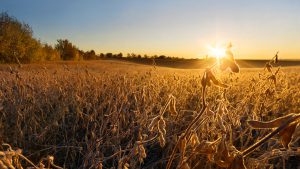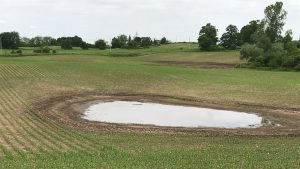Today and tomorrow
THE WORLD NEEDS GRAIN FARMERS

It’s difficult to make predictions, especially about the future.
— Danish proverb
THE FUTURE IS destined to lead us to the unexpected, let alone to the unknown. After all, when Grain Farmers of Ontario was launched in 2010, who thought the likes of gluten, pollinators and food waste would be dominating headlines 10 years later? So it follows that predicting what 2030 will look like is an inexact science. But given that farming is a long-term venture, it is worth gazing into the crystal ball to see what might be on the horizon. And when you do, you find definite clues to follow, and areas on which to focus for planning and management.
IRON DECLINES, DATA RISES
All indications point to iron on the farm shrinking. That will be a blow to tradition, but equipment manufacturer representatives say we’ll need to get used to it, as farming gets more precise.
“The tractor will no longer be king,” says Charlie O’Brien, a long-time agricultural equipment consultant and secretary general of the global Agrievolution Alliance of equipment manufacturers. “It will still be the power, not the brains. Implements that talk to each other, guided by data, will drive the tractor, not the other way around, and autonomous vehicles will change the look of equipment in the field.”
Data will fuel progress — depending significantly on broadband availability in rural Ontario, a thorn presently in the side of many producers. But the province promised to address this gap; in July it committed $315 million for broadband and cellular expansion, expected to improve internet and cell service for up to 220,000 Ontario homes and businesses.
Better digital service and automation will mean farmers spend more time on their phones or in their offices managing their operations, and less time engaged in manual labour. J.P. Gervais, chief agriculture economist for Farm Credit Canada, says that change can’t come too soon, given the extent of labour challenges.
“Automation will play a critical role in addressing the labour shortages for Canadian farmers,” he says. “I believe that by 2030, grain farmers will have fully mastered and leveraged the power of data, while automation becomes the next technology driver keeping Ontario farmers competitive in the global marketplace.”
THE WORLD NEEDS GRAIN FARMERS
Gervais predicts that although grumblings and actions have marked the recent past, there will be more global trade 10 years from now — not less.
“Despite what appears to be a pushback currently against free trade, the growing population requires a larger quantity of food,” he says.
Weather events and environmental pressures will make this task more challenging for producers. But that won’t stop Canada and other large food-producing countries from being called on to target their production and supply more to food import-dependent countries. To meet demand, there will need to be as few impediments as possible so producers can work at capacity — and get access to the markets where they’re needed.
“Efficient infrastructure to reach global markets will be critical to realize Canada’s potential as a preferred supplier of food to the world,” says Gervais.
Ironically, while the hungry, developing world is reaching out for better nutrition, consumers here are still sorting out whether or not they trust farmers. The Canadian Centre for Food Integrity says an alarming 91 per cent of Canadians say they know little, very little or nothing about modern farming practices in Canada. Fortunately, 60 per cent of survey respondents are interested in knowing more about agriculture and how their food is produced.
So in 10 years, an active agricultural literacy campaign will have been long underway, with grain farmers actively involved and consumers watching closely.
“Some of our modern farming practices will be better understood then,” says Jeff Loessin, London Ontario-based corn and soybean seed category leader for Corteva Agriscience in Canada. “Governments will need to be advocates for agriculture and have a bigger voice, as will companies. We all have a role in increasing awareness and understanding.”
HEALTH, ENVIRONMENT INFLUENCES CROPPING DECISIONS
Loessin says technology’s ability to improve human and animal health will move consumers from being averse to change, and influence trait development.
“Society’s acceptance level of agricultural technology is low now and not necessarily improving, but we can change that,” he says. “Most of the traits introduced through technology have been input traits. As science continues to uncover what makes our bodies work better, the opportunity for agriculture to be involved in providing solutions increases. We can modify crops to meet consumers’ demands.”
And that’s fine — but what about the environment? In 10 years, the public will demand even higher levels of what some already consider excessive scrutiny of farming practices. Again, that’s where education and literacy must prevail, says Loessin, helping people understand for example how plants sequester carbon or in some cases fix their own nitrogen.
Ontario grain farmers will need their pro-environment message understood abroad to nations making increasingly tough decisions about who will be their trading partners. Loessin says emerging grain export nations — Russia and Ukraine, for example — may beat Canada on price, but not on quality or sophisticated, responsible production.
Near or far, though, consumers rule. “Consumers have moved from being influenced, to being influencers themselves when it comes to food trends,” says FCC’s Gervais. “This shift will only intensify. Grain farmers will need to be even more attentive to how food preferences evolve to be able to capture the full value of their crops in the food supply chain.”
University of Guelph human health and nutritional science professor Alison Duncan says the future holds major opportunities for protein innovation. That’s stemming from consumers’ demand for plant-based protein and, in particular, reaction to rising meat prices due to the effects of African Swine Fever…which could linger for years.
“Currently, we’re seeing a lot of plant-based products made from pea protein isolate,” she says, “but there will be an opportunity to expand this to other high-density vegetable proteins that can come from crops such as soybeans and pulses other than peas.”
EFFECTIVE MANAGEMENT AND STEWARDSHIP ARE TIMELESS
Harold Rudy, former senior manager at the Ontario Soil and Crop Improvement Association and author of the book The Soil Fixers, says 10 years from now good soil management and stewardship will continue to be a producer priority.
Rudy says top producers will pay detailed attention to their soil. They’ll strive for the best physical, chemical and biological activity, targeting an ideal soil composition of 45 per cent mineral, 25 per cent air, 25 per cent water and five per cent organic matter. He says drainage is at the top of the list for achieving that desired ratio, along with crop rotation that includes forages and cover crops where possible, with minimum tillage and controlled traffic to reduce or eliminate soil compaction.
For his part, Loessin urges producers to look to the future with an eye towards stewarding crop protection technology, particularly with new chemistries, products and approaches coming onstream.
For example, he points to the introduction of biologicals that are safer for the environment, and naturally derived, highly targeted products that have exceptional health and safety profiles.
“Insects and weeds will all evolve over time, that’s a safe prediction,” he says. “The tools we have available to improve a crop will need to be stewarded so we don’t lose them.” •





















